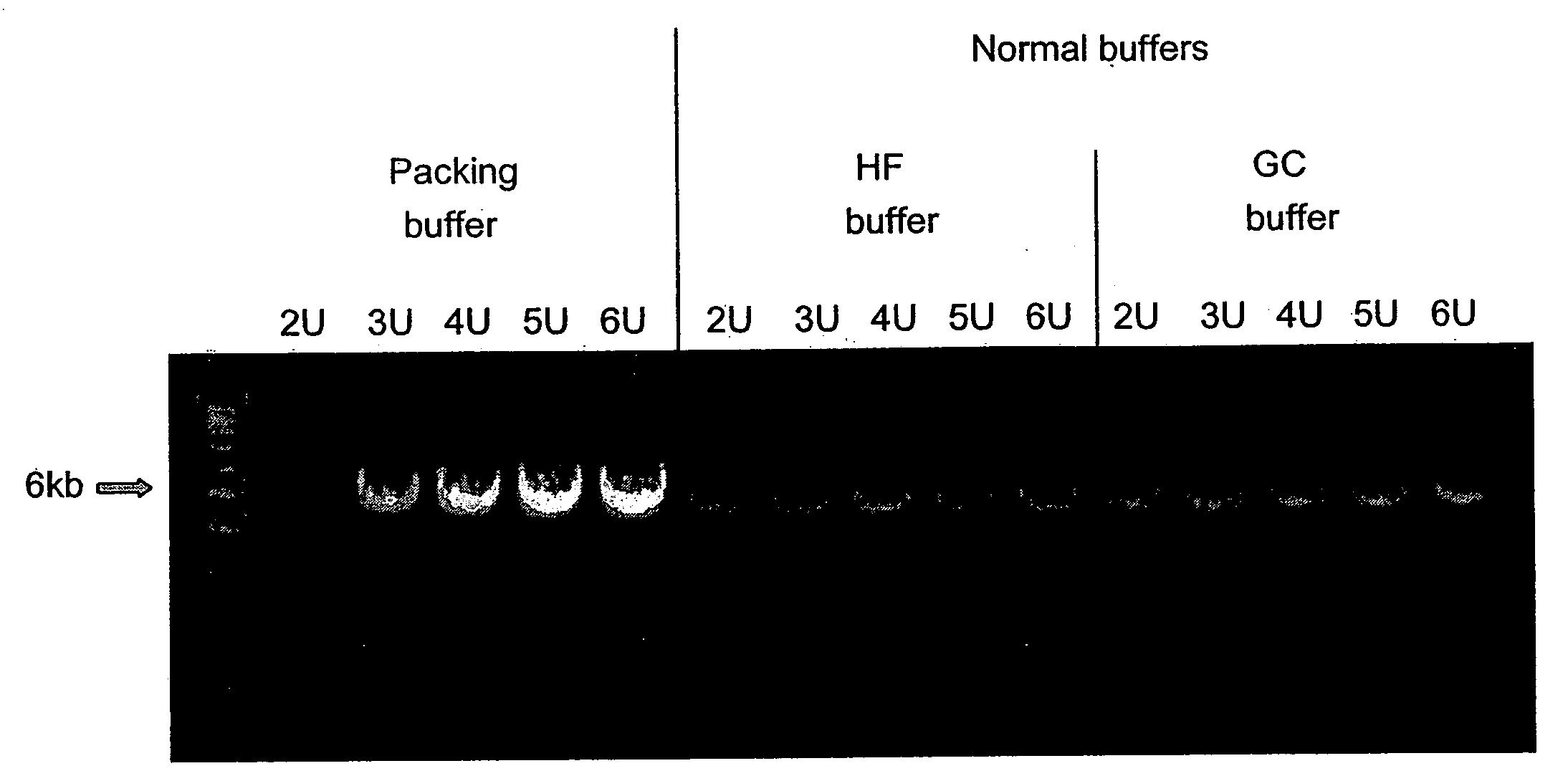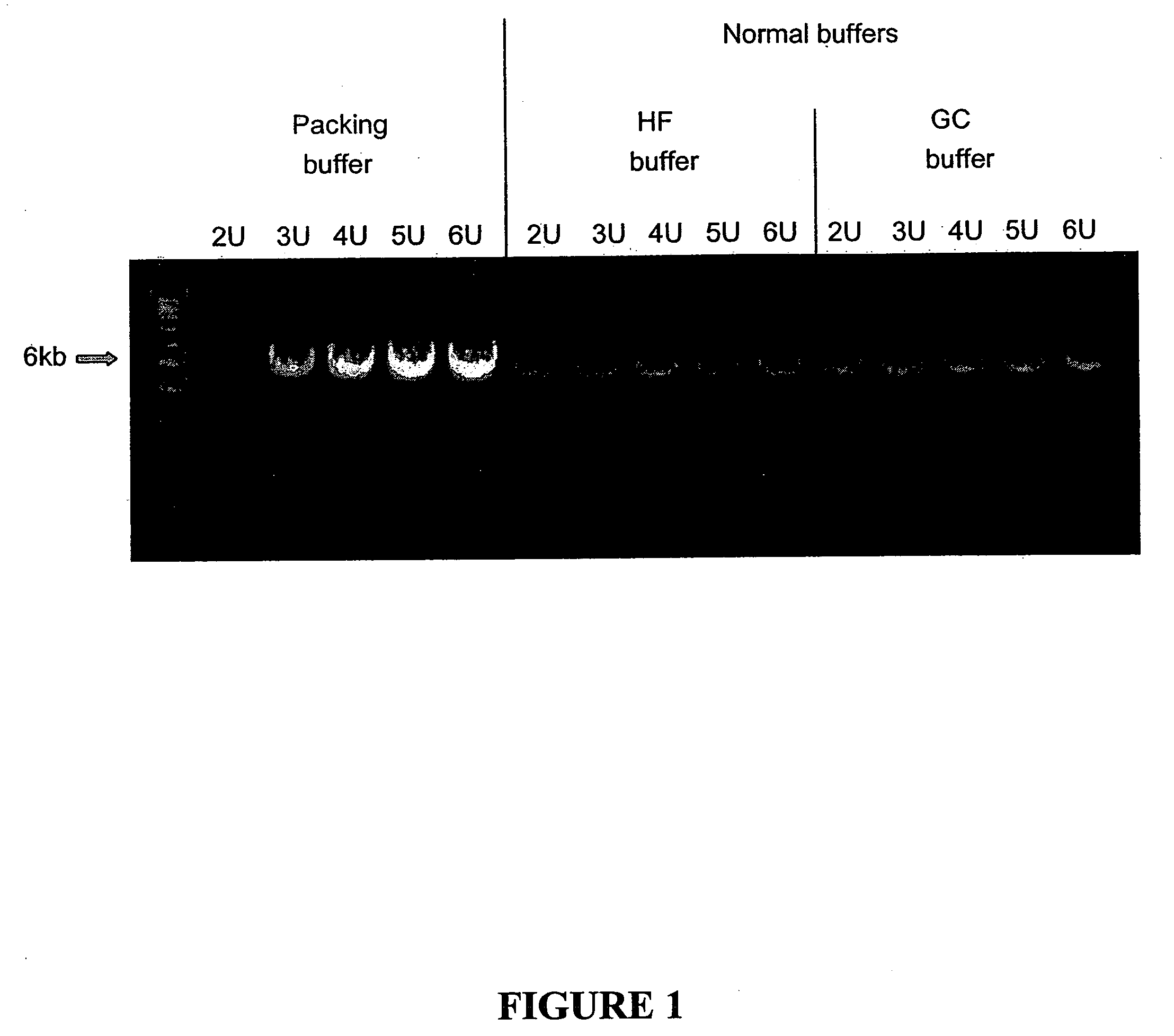Reaction buffer composition for nucleic acid replication with packed DNA polymerases
a nucleic acid and buffer composition technology, applied in the field of replication, amplification or mutagenesis of nucleic acid sequences, can solve the problems of limited sensitivity and kinetics of amplification techniques such as the polymerase chain reaction (pcr), increasing the concentration of dna, and significant limitation
- Summary
- Abstract
- Description
- Claims
- Application Information
AI Technical Summary
Benefits of technology
Problems solved by technology
Method used
Image
Examples
example 1
[0112] A 5× packing PCR reaction buffer was prepared according to the table below.
Final 5×Concen-MaterialSourceStockAmounttrationTrisSigma,1 M stock75ml150mMsulfate / Trisultrapuresolution,basepH 10.0PotassiumSigma,0.5 M stock200ml200mMsulfateultrapuresolutionAmmoniumJ. T. Baker,1 M stock2.5ml5mMsulfateultrapuresolutionMagnesiumSigma,1 M stock5ml10mMsulfateultrapuresolutionTritonSigma,10% stock25ml0.5%X-100ultrapuresolutionWaterUltrapure,192.5mlDNase-RNase-free
[0113] The Tris sulfate 1M stock solution is prepared by mixing a solution of 1M Tris base (Sigma, ultrapure) with an appropriate amount of a solution of 1M Tris sulfate (Sigma, ultrapure) to obtain a pH of 10.0.
[0114] Amplification of a 6 kb DNA standard (human beta globin) was performed using the 5× packing PCR reaction buffer to obtain a final reaction solution with 1× concentrations. Final concentration or amount of reagents per 50 μl reaction was 200 μM of each of the four deoxyribonucleoside triphosphates, 100 ng of hum...
example 2
[0115] Experiments were performed with different mineral salts using packed DNA polymerase to determine the optimal concentration of salt in the reaction buffers. The reactions were performed as described above in Example 1, with several exceptions. The mineral salts tested were CsCl, KNO3, and CsNO3. The ranges of concentrations of each mineral salt used in the experiments were as follows: CsCl: 50-120 mM; KNO3: 15-110 mM; and CsNO3: 30-100 mM. In addition, each mineral salt was tested in a thermocycling reaction using 20 U of DNA polymerase (Pfu-Sso7d polymerase fusion) were used. The results demonstrate increasing the concentration of mineral salt over the range of 50 to 120 mM per reaction increases product yield in a reaction with 20U DNA polymerase. The results also demonstrate that the optimal concentration range for mineral salts in a packed buffer composition is in the range of 80 and 100 mM.
PUM
| Property | Measurement | Unit |
|---|---|---|
| Temperature | aaaaa | aaaaa |
| Temperature | aaaaa | aaaaa |
| Fraction | aaaaa | aaaaa |
Abstract
Description
Claims
Application Information
 Login to View More
Login to View More - R&D
- Intellectual Property
- Life Sciences
- Materials
- Tech Scout
- Unparalleled Data Quality
- Higher Quality Content
- 60% Fewer Hallucinations
Browse by: Latest US Patents, China's latest patents, Technical Efficacy Thesaurus, Application Domain, Technology Topic, Popular Technical Reports.
© 2025 PatSnap. All rights reserved.Legal|Privacy policy|Modern Slavery Act Transparency Statement|Sitemap|About US| Contact US: help@patsnap.com


